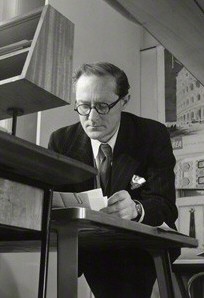
Sir Hugh Maxwell Casson was a British architect, also active as an interior designer, an artist, and a writer and broadcaster on twentieth-century design. He was the director of architecture for the 1951 Festival of Britain. From 1976 to 1984, he was president of the Royal Academy.
Sir Nicholas Grimshaw is a prominent English architect, particularly noted for several modernist buildings, including London's Waterloo International railway station and the Eden Project in Cornwall. He was President of the Royal Academy from 2004 to 2011. He was chairman of Grimshaw Architects from its foundation to 2019, when he was succeeded by Andrew Whalley. He is a recipient of the RIBA Gold Medal.

Sir Peter Cook is an English architect, lecturer and writer on architectural subjects. He was a founder of Archigram, and was knighted in 2007 by the Queen for his services to architecture and teaching. He is also a Royal Academician and a Commandeur de l'Ordre des Arts et des Lettres of the French Republic. His achievements with Archigram were recognised by the Royal Institute of British Architects in 2004, when the group was awarded the Royal Gold Medal.

Stephen Hodder is an English architect who won the RIBA's Stirling Prize in 1996. He is also a partner at his own practice Hodder Associates which was founded in 1992 in Manchester. In 2012, Hodder was elected for a two-year term as the president of the RIBA (2013–2015).

Joseph Rykwert CBE is Paul Philippe Cret Professor Emeritus of Architecture at the University of Pennsylvania, and one of the foremost architectural historians and critics of his generation. He has spent most of his working life in the United Kingdom and America. He has taught the history and theory of architecture at several institutions in Europe and North America. Rykwert is the author of many influential works on architecture, including The Idea of a Town (1963), On Adam's House in Paradise (1972), The Dancing Column (1996) and The Seduction of Place (2000). All his books have been translated into several languages.

Dennis Sharp was a British architect, professor, curator, historian, author and editor. His obituary in The Guardian stated that he 'was well-known as an architectural historian, teacher and active defender of the environment. However, his reputation in those fields rather overshadowed his considerable success as a working architect and his long-term commitment to environmentally friendly building'.

WilkinsonEyre is an international architecture practice based in London, England. In 1983 Chris Wilkinson founded Chris Wilkinson Architects, he partnered with Jim Eyre in 1987 and the practice was renamed WilkinsonEyre in 1999. The practice has led the completion of many high-profile projects such as Gateshead Millennium Bridge, Cooled Conservatories Gardens by the Bay, Oxford's Weston Library and Guangzhou International Finance Center.

Paul Hereford Oliver MBE was an English architectural historian and writer on the blues and other forms of African-American music. He was equally distinguished in both fields, although it is likely that aficionados of one of his specialties were not aware of his expertise in the other. He wrote some of the first scholarly studies of blues music, and his commentary and research have been influential.
Geoffrey Coker Arding Adams was an English first-class cricketer and newspaper proprietor.
Thomas Paul Richard Bloxham MBE is a British property developer, founder of award winning urban renewal property development company Urban Splash and the modern housebuilder House by Urban Splash - companies which have won 450 awards to date for architecture, design and business success.
Grimshaw Architects is an architectural firm based in London. Founded in 1980 by Nicholas Grimshaw, the firm was one of the pioneers of high-tech architecture. In particular, they are known for their design of transport projects including Amsterdam Bijlmer ArenA railway station, Waterloo International railway station and the award-winning Southern Cross railway station which was the recipient of the Royal Institute of British Architects Lubetkin Prize. Grimshaw is behind the design of the Sustainability Pavilion, an innovative net-zero building, for Expo 2020. The firm currently has offices in Los Angeles, New York, London, Paris, Dubai, Melbourne and Sydney, employing over 600 staff.

Imran Amed is a Canadian-British fashion media entrepreneur, the founder, and editor-in-chief of the website The Business of Fashion.

Andrew David Whalley is an architect registered in the United Kingdom and United States of America. His speciality is ecological design. In 2011, he was named Deputy Chairman of the international architecture firm Grimshaw Architects. He became chairman in 2019.
Seymour Slive was an American art historian, who served as director of the Harvard Art Museums from 1975 to 1984. Slive was a scholar of Dutch art, specifically of the artists Rembrandt, Frans Hals, and Jacob van Ruisdael.

The RIBA Journal is an architecture magazine and website published by the Royal Institute of British Architects, based in London. It has the largest circulation of any UK-originating architecture magazine. Alongside the monthly publication in print, the online edition is updated daily and has additional content.

Mark Sealy is a British curator and cultural historian with a special interest in the relationship of photography to social change, identity politics and human rights. In 1991 he became the director of Autograph ABP, the Association of Black Photographers, based since 2007 at Rivington Place, a purpose-built international visual arts centre in Shoreditch, London. He has curated several major international exhibitions and is also a lecturer.
Sadie Anna Morgan is an English designer. In 1995 she founded dRMM, the RIBA Stirling Prize winning architecture practice, with Alex de Rijke and Philip Marsh.
Elsie Owusu is a Ghana-born British architect, a founding member and the first chair of the Society of Black Architects. She is also known to have co-led the refurbishment of the Supreme Court of the United Kingdom in 2009 and worked on Green Park tube station. She has been an elected Royal Institute of British Architects (RIBA) Council member since 2014, and vice-chair of the London School of Architecture.
Wright & Wright Architects is a British architectural firm, founded in 1994 by Sandy and Clare Wright. The firm is based in Camden Town, London.










